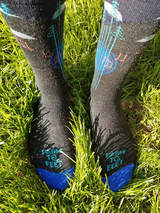
So a few weeks ago I did a post about a pair of socks I bought, and based around the information I was able to gather it looked like there were a number of positive aspects to the sustainability efforts of Farm to Feet socks, but there were some unanswered questions. Well, my post was found by the company, and Farm to Feet’s sustainability manager provided some great information to fill in the gaps.. So here it is:
Animal Welfare/Mulesing
They do not address mulesing because the wool they use comes from American sheep, and the practice is not used here since the fly that causes flystrike does not exist in North America.
Nylon & Spandex
The raw materials unfortunately do come from virgin resources, but they are making an effort to work with suppliers to find more sustainable alternatives.
Paperboard & Ink
For their packaging they have now switched to Forest Stewardship Council (FSC) Certified paper. (Side note, if you’re wondering about the history of FSC, here is a link to an article from Greenpeace, who is a founding member) Farm to Feet has also reduced the size of their packaging, which is a win-win since it both reduced their shipping costs and associated transportation emissions. Their packaging suppliers also use vegetable-based inks.
Dyeing
Farm to Feet ensures that their suppliers are compliant with bluesign, a process and certification for sustainable textile production that eliminates harmful substances from the supply chain.
Higg Index
Farm to Feet’s parent company, Nester Hosiery, was the first sock manufacturer to complete the Higg Index, and are a member of the Outdoor Industry Association (OIA) Sustainability Working Group.
I’d like to thank Farm to Feet for reaching out and putting the time in to address these issues. On my end, as I explore these topics I hope to share what I can with the world and take you on this journey with me. I have now added Farm to Feet to the Buying Guide, you can find them on the Clothing, Hike, Snow and Footwear pages.
Animal Welfare/Mulesing
They do not address mulesing because the wool they use comes from American sheep, and the practice is not used here since the fly that causes flystrike does not exist in North America.
Nylon & Spandex
The raw materials unfortunately do come from virgin resources, but they are making an effort to work with suppliers to find more sustainable alternatives.
Paperboard & Ink
For their packaging they have now switched to Forest Stewardship Council (FSC) Certified paper. (Side note, if you’re wondering about the history of FSC, here is a link to an article from Greenpeace, who is a founding member) Farm to Feet has also reduced the size of their packaging, which is a win-win since it both reduced their shipping costs and associated transportation emissions. Their packaging suppliers also use vegetable-based inks.
Dyeing
Farm to Feet ensures that their suppliers are compliant with bluesign, a process and certification for sustainable textile production that eliminates harmful substances from the supply chain.
Higg Index
Farm to Feet’s parent company, Nester Hosiery, was the first sock manufacturer to complete the Higg Index, and are a member of the Outdoor Industry Association (OIA) Sustainability Working Group.
I’d like to thank Farm to Feet for reaching out and putting the time in to address these issues. On my end, as I explore these topics I hope to share what I can with the world and take you on this journey with me. I have now added Farm to Feet to the Buying Guide, you can find them on the Clothing, Hike, Snow and Footwear pages.

 RSS Feed
RSS Feed